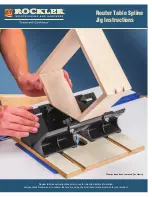
ASSEMbLY & ADJUSTMENTS
Installing and using starter pin
Warning!
Use of the starting pin should only be attempted by advanced users.
If you have never used this method, it is recommended you get training from a
qualified person. Failure to comply may result in serious injury.
The starting pin (A) Fig.8 & Fig.9 gets installed to the table in either the right or
left side of the mounting holes (B) Fig.8. The starter pin is used to support the
work when starting a cut.
1. The workpiece (B) Fig.9 should be placed in the position 1, using the starter
pin (A) as a support.
2. Swing the workpiece into the cutter (C) as shown in the position 2 (Fig.9).
The workpiece is now supported by the starter pin and the collar.
3. After the cut has been started, the workpiece is swung free of the starter pin
and only rides against the collar as shown in position 3. Always feed against
the cutter rotation.
Installing miter gauge
1. Slide the miter gauge (A) Fig.10 into the T-slot in the table top.
2. Loosen lock handle (B). To adjust the body (C) of the miter gauge to the
desired angle:
3. Pull the spring-loaded knob (D) out and turn until the body (C) of the miter
gauge is at the desired angle as indicated on the scale.
4. Retighten lock handle (B).
Miter gauge indent settings
There are indents at the 0º, 30º and 45º right and left positions. At these
settings, release the knob (D) Fig.10 to engage the stop rod. Then tighten the
lock handle (B).
Note:
Do not rely solely on the indents for an accurate setting. After the stop
rod engages at the 0º, 30º and 45º positions, make a fine adjustment with the
knob (D), if necessary, setting it against the scale indicator.
Adjusting miter gauge
1. Set the miter gauge to 90º (0º setting on the scale) by loosening the lock
handle (B) Fig.10, then pulling the spring-loaded knob (D) out and turning
the body (C) until 0º is indicated on the scale (E).
2. Measure the accuracy of the miter gauge against the T-slot with a
combination square.
If adjustment is necessary:
3. Adjust the body (C) until it is perfectly square (90º) to the T-slot (F).
4. Tighten the lock handle (B). Verify that the scale indicator (G) reads 0º. If
further adjustment is necessary:
5. Loosen the screw (H) and adjust the indicator (G) until it reads 0º
6. Retighten screw (H).
The miter gauge should fit snugly within the T-slot while still sliding easily. The
bar of the miter gauge has two slots, each with a set screw. Rotate one or both
of these set screws with a hex. key as needed to eliminate any play between
the miter gauge bar and T-slot.
FIGURE 8
FIGURE 9
FIGURE 10





































